

Eye Direction and Lying - How to detect lies from the direction of an individual's gaze / visual accessing cues. Interesting Info -> Lying Index -> Eye Direction & Visual Accessing Cues Eye Movement and Direction & How it Can Reveal Truth or Lies This is a continuation of our previous article Detecting Lies.

Many comments by our visitors asked about how eye direction can indicate the presence of a lie. Can the direction a person's eyes reveal whether or not they are making a truthful statement? Short answer: sort of. In these shows a detective will deduce if a person is being untruthful simply because they looked to the left or right while making a statement. In reality, it would be foolish to make such a snap judgment without further investigation... but the technique does have some merit.
So, here it is... read, ponder and test it on your friends and family to see how reliable it is for yourself. Body Language Basics - Syncrat Publishing. Throughout history it has been an advantage if an individual can read body language.
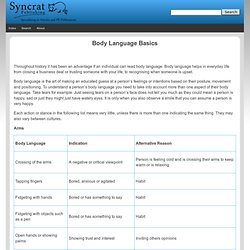
Body language helps in everyday life from closing a business deal or trusting someone with your life, to recognising when someone is upset. The Top 10 Psychology Studies of 2010. The end of 2010 fast approaches, and I'm thrilled to have been asked by the editors of Psychology Today to write about the Top 10 psychology studies of the year. I've focused on studies that I personally feel stand out, not only as examples of great science, but even more importantly, as examples of how the science of psychology can improve our lives. Each study has a clear "take home" message, offering the reader an insight or a simple strategy they can use to reach their goals , strengthen their relationships, make better decisions, or become happier.
25 Acts of Body Language to Avoid. Our body language exhibits far more information about how we feel than it is possible to articulate verbally.
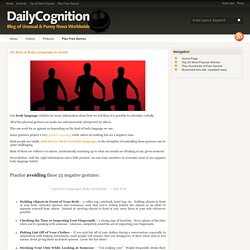
All of the physical gestures we make are subconsciously interpreted by others. This can work for or against us depending on the kind of body language we use. Some gestures project a very positive message, while others do nothing but set a negative tone. Most people are totally oblivious to their own body language, so the discipline of controlling these gestures can be quite challenging. Most of them are reflexive in nature, automatically matching up to what our minds are thinking at any given moment.
Nevertheless, with the right information and a little practice, we can train ourselves to overcome most of our negative body language habits. Practice avoiding these 25 negative gestures: “ I speak two languages, Body and English. ” — Mae West Holding Objects in Front of Your Body – a coffee cup, notebook, hand bag, etc. Want to know powerful, dominant, confident body language postures? 10 Simple Postures That Boost Performance. Psychological research suggests simple actions can project power, persuade others, increase empathy, boost cognitive performance and more… We tend to think of body language as something that expresses our internal states to the outside world.

But it also works the other way around: the position of our body also influences our mind. As the following psychological research shows, how we move can drive both thoughts and feelings and this can boost performance. 1. Pose for power If you want to feel more powerful then adopt a powerful posture. 2. Tensing up your muscles can help increase your willpower. 3.
If you’re stuck on a problem which needs persistence then try crossing your arms. 4. If crossing your arms doesn’t work then try lying down. The What-The-Hell Effect. What pizza and cookies can teach us about goal-setting.
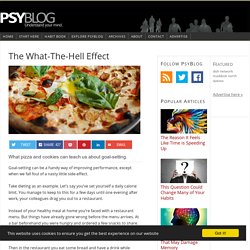
Stanley Milgram: Obedience to Authority Or Just Conformity? What psychological experiment could be so powerful that simply taking part might change your view of yourself and human nature?
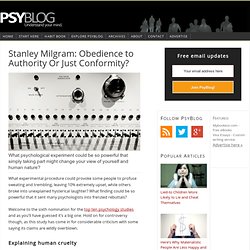
What experimental procedure could provoke some people to profuse sweating and trembling, leaving 10% extremely upset, while others broke into unexplained hysterical laughter? What finding could be so powerful that it sent many psychologists into frenzied rebuttals? Welcome to the sixth nomination for the top ten psychology studies and as you’ll have guessed it’s a big one. Bystander Effect. When the presence of others reduces helping behaviours.
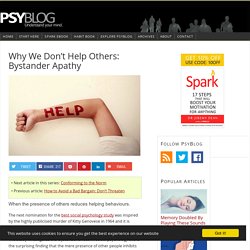
The next nomination for the best social psychology study was inspired by the highly publicised murder of Kitty Genovese in 1964 and it is mentioned in every textbook and often dubbed ‘seminal’. The study investigates the ‘bystander effect’. In social psychology this is the surprising finding that the mere presence of other people inhibits our own helping behaviours in an emergency. John Darley and Bibb Latane were inspired to investigate emergency helping behaviours after the murder of Kitty Genovese in 1964.
The newspaper report of the murder stated that 38 people had heard and seen the attack, which lasted an hour, yet they did nothing. Stanford Prison Experiment. The experiment that inspired a novel, two films, countless TV programs, re-enactments and even a band.

“The vilest deeds like poison weeds bloom well in prison air” – Oscar Wilde. Cognitive Dissonance. Understanding this experiment sheds a brilliant light on the dark world of our inner motivations.

The ground-breaking social psychological experiment of Festinger and Carlsmith (1959) provides a central insight into the stories we tell ourselves about why we think and behave the way we do. The experiment is filled with ingenious deception so the best way to understand it is to imagine you are taking part. So sit back, relax and travel back. The time is 1959 and you are an undergraduate student at Stanford University… The Top 10 Psychology Studies of 2010. 15 Styles of Distorted Thinking.